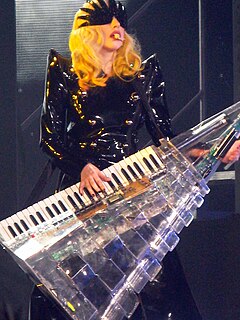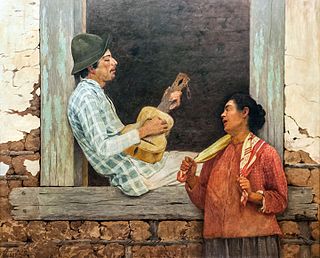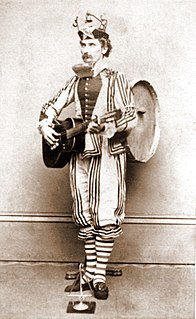Related Research Articles
In music, a glissando is a glide from one pitch to another. It is an Italianized musical term derived from the French glisser, "to glide". In some contexts, it is distinguished from the continuous portamento. Some colloquial equivalents are slide, sweep, bend, smear, rip, lip, plop, or falling hail.

A musical ensemble, also known as a music group or musical group, is a group of people who perform instrumental or vocal music, with the ensemble typically known by a distinct name. Some music ensembles consist solely of instruments, such as the jazz quartet or the orchestra. Some music ensembles consist solely of singers, such as choirs and doo wop groups. In both popular music and classical music, there are ensembles in which both instrumentalists and singers perform, such as the rock band or the Baroque chamber group for basso continuo and one or more singers. In classical music, trios or quartets either blend the sounds of musical instrument families or group together instruments from the same instrument family, such as string ensembles or wind ensembles. Some ensembles blend the sounds of a variety of instrument families, such as the orchestra, which uses a string section, brass instruments, woodwinds and percussion instruments, or the concert band, which uses brass, woodwinds and percussion.

A percussion instrument is a musical instrument that is sounded by being struck or scraped by a beater including attached or enclosed beaters or rattles struck, scraped or rubbed by hand or struck against another similar instrument. Excluding zoomusicological instruments and the human voice, the percussion family is believed to include the oldest musical instruments.

String instruments, stringed instruments, or chordophones are musical instruments that produce sound from vibrating strings when the performer plays or sounds the strings in some manner.

Throughout history, various methods of musical instrument classification have been used in organology. The most commonly used system divides instruments into string instruments, woodwind instruments, brass instruments and percussion instruments; however, other schemes have been devised.
Hornbostel–Sachs or Sachs–Hornbostel is a system of musical instrument classification devised by Erich Moritz von Hornbostel and Curt Sachs, and first published in the Zeitschrift für Ethnologie in 1914. An English translation was published in the Galpin Society Journal in 1961. It is the most widely used system for classifying musical instruments by ethnomusicologists and organologists. The system was updated in 2011 as part of the work of the Musical Instrument Museums Online (MIMO) Project.

A chordophone is a musical instrument that makes sound by way of a vibrating string or strings stretched between two points. It is one of the four main divisions of instruments in the original Hornbostel-Sachs scheme of musical instrument classification.
General MIDI is a standardized specification for electronic musical instruments that respond to MIDI messages. GM was developed by the American MIDI Manufacturers Association (MMA) and the Japan MIDI Standards Committee (JMSC) and first published in 1991. The official specification is available in English from the MMA, bound together with the MIDI 1.0 specification, and in Japanese from the Association of Musical Electronic Industry (AMEI).

GarageBand is a line of digital audio workstations for macOS, iPadOS, and iOS devices that allows users to create music or podcasts. GarageBand is developed and sold by Apple for macOS, and is part of the iLife software suite, along with iMovie and iDVD. Its music and podcast creation system enables users to create multiple tracks with pre-made MIDI keyboards, pre-made loops, an array of various instrumental effects, and voice recordings.

The keytar is a lightweight synthesizer that is supported by a strap around the neck and shoulders, similar to the way a guitar is supported by a strap. Keytars allow players a greater range of movement onstage, compared to conventional keyboards, which are placed on stationary stands or which are part of heavy, floor-mounted structures. The instrument has a musical keyboard for triggering musical notes and sounds. Various controls are placed on the instrument's "neck", including those for pitch bends, vibrato, portamento, and sustain.

A folk instrument is a musical instrument that developed among common people and usually does not have a known inventor. It can be made from wood, metal or other material. Such an instrument is played in performances of folk music.

A one-man band is a musician who plays a number of instruments simultaneously using their hands, feet, limbs, and various mechanical or electronic contraptions. One-man bands also often sing while they perform.
The Jono El Grande Orchestra was formed in 2000 by composer Jono El Grande. TJEGO exclusively performs Jono El Grande's music and consists of selected musicians who have played with Oslo Philharmonic Orchestra, Oslo Sinfonietta and Poing.

In music, a trio is 1) a composition for three performers or three musical parts, 2) in larger works the middle section of a ternary form, which was in history often a trio composition instruments, and 3) an ensemble of three instruments or voices performing trio compositions.
The Bachianas Brasileiras are a series of nine suites by the Brazilian composer Heitor Villa-Lobos, written for various combinations of instruments and voices between 1930 and 1945. They represent a fusion of Brazilian folk and popular music on the one hand and the style of Johann Sebastian Bach on the other, as an attempt to freely adapt a number of Baroque harmonic and contrapuntal procedures to Brazilian music. Most of the movements in each suite have two titles: one "Bachian", the other Brazilian.

Stuart Saunders Smith is an American composer and percussionist. After having studied composition and music theory at three music institutions, Smith is currently based in Vermont, America with his wife Sylvia. He has produced almost 200 compositions, half of which were written for percussion instruments with a focus on the vibraphone.
Chôros is the title of a series of compositions by the Brazilian composer Heitor Villa-Lobos, composed between 1920 and 1929.

A musical instrument is a device created or adapted to make musical sounds. In principle, any object that produces sound can be considered a musical instrument—it is through purpose that the object becomes a musical instrument. The history of musical instruments dates to the beginnings of human culture. Early musical instruments may have been used for ritual, such as a horn to signal success on the hunt, or a drum in a religious ceremony. Cultures eventually developed composition and performance of melodies for entertainment. Musical instruments evolved in step with changing applications and technologies.

Music technology is the study or the use of any device, mechanism, machine or tool by a musician or composer to make or perform music; to compose, notate, play back or record songs or pieces; or to analyze or edit music.

Mechanical music technology is the use of any device, mechanism, machine or tool by a musician or composer to make or perform music; to compose, notate, play back or record songs or pieces; or to analyze or edit music. The earliest known applications of technology to music was prehistoric peoples' use of a tool to hand-drill holes in bones to make simple flutes. Ancient Egyptians developed stringed instruments, such as harps, lyres and lutes, which required making thin strings and some type of peg system for adjusting the pitch of the strings. Ancient Egyptians also used wind instruments such as double clarinets and percussion instruments such as cymbals. In Ancient Greece, instruments included the double-reed aulos and the lyre. Numerous instruments are referred to in the Bible, including the horn, pipe, lyre, harp, and bagpipe. During Biblical times, the cornet, flute, horn, organ, pipe, and trumpet were also used. During the Middle Ages, hand-written music notation was developed to write down the notes of religious Plainchant melodies; this notation enabled the Catholic church to disseminate the same chant melodies across its entire empire.
References
- Steven Appleby and George Mole, Better Living Through Air Guitar, 2005-03-11, publisher: Piatkus, ISBN 978-0-7499-5094-1, ISBN 0-7499-5094-3.
- Rolf Inge Godøy1, Egil Haga1 and Alexander Refsum Jensenius1, "Playing 'Air Instruments': Mimicry of Sound-Producing Gestures by Novices and Experts", Gesture in Human-Computer Interaction and Simulation, February 2006, University of Oslo, Department of Musicology, Oslo, Norway, ISBN 978-3-540-32624-3.